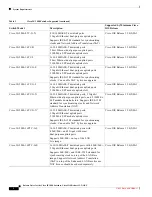
15
Release Notes for the Cisco IE 2000 Switches, Cisco IOS Release 15.2(1)EY
NEW DOC # PENDING
Important Notes
Beginning in privileged EXEC mode, follow these steps to configure the HTTP server interface:
•
Express Setup uses the HTTP protocol (the default is port 80) and the default method of
authentication (the enable password) to communicate with the switch through any of its Ethernet
ports and to allow switch management from a standard web browser.
If you change the HTTP port, you must include the new port number when you enter the IP address
in the browser
Location
or
Address
field (for example, http://10.1.126.45:184 where 184 is the new
HTTP port number). Write down the port number through which you are connected. Use care when
changing the switch IP information.
If you are
not
using the default method of authentication (the enable password), you need to
configure the HTTP server interface with the method of authentication used on the switch.
Beginning in privileged EXEC mode, follow these steps to configure the HTTP server interface:
Note
IE-2000-4S-TS-G do not have copper ports for PC, a GLC-T copper SFP is required to perform express
setup.
Command Purpose
Step 1
configure terminal
Enters global configuration mode.
Step 2
ip http authentication
{
aaa | enable
|
local
}
Configures the HTTP server interface for the type of authentication that
you want to use.
•
aaa
—Enables the authentication, authorization, and accounting
feature. You must enter the
aaa new-model
interface configuration
command for the
aaa
keyword to appear.
•
enable
—Enables the password, which is the default method of
HTTP server user authentication.
•
local
—Specifies the local user database, as defined on the Cisco
router or access server.
Step 3
end
Returns to privileged EXEC mode.
Step 4
show running-config
Verifies your entries.
Command Purpose
Step 1
configure terminal
Enters global configuration mode.
Step 2
ip http authentication
{
enable
|
local
|
tacacs
}
Configures the HTTP server interface for the type of authentication that
you want to use.
•
enable
—Enables the password, which is the default method of
HTTP server user authentication.
•
local
—Specifies the local user database, as defined on the Cisco
router or access server.
•
tacacs
—Specifies the TACACS server.
Step 3
end
Returns to privileged EXEC mode.
Step 4
show running-config
Verifies your entries.


















